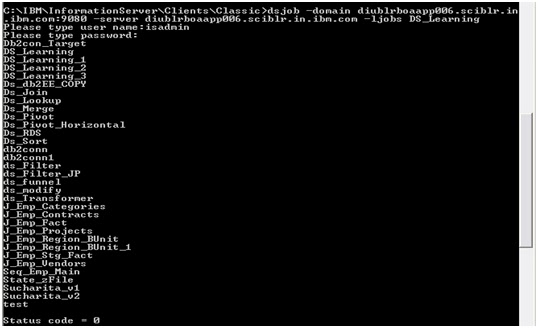Execute Command In Datastage
Almost every Data warehousing project requires that your job runs in batches at specified time slots. In many cases they batches may be consisting of jobs from different systems in addition to the ones in Datastage. In such cases the Datastage jobs are usually scheduled by using an external scheduling tool like ESP Scheduler, Control M, Autosys, etc… This is made possible by writing scripts that will run your jobs through the command line. I would consider the command line a very powerful interface to Datastage which lets us do more than just run the normal job. There guides present in the Datastage documentation will be very helpful in exploring the various things that can be done through the command line. However I plan on giving you the basics you will need to need to carry out your execution
IN UNIX, the Datastage home directory location will always be specified in the “.dshome” file which will be present in the root directory. Before you can run your Datastage commands you will have to run the following commands
- cd `cat /.dshome`
Command The full pathname of the command to execute. This can be an operating system command, a batch command file, or an executable file. You can use a job parameter so that you can specify the actual command at run time. Parameters entered in this field needs to be delimited with hashes (#).
This will change the location to the home directory. By default this will be /opt/IBM/InformationServer/Server/DSEngine
- . ./dsenv > /dev/null 2>&1
This will run the dsenv file which contains all the environment variables. Without doing this, your UNIX commands won’t run on the command prompt.
After you have done this then you can use any Datastage command for interacting with the server. The main command you can use is the ‘dsjob’ command which is not used only to run jobs but for a wide variety of reasons. Let’s look at the various ways you can use the dsjob command
To run a job
Using the dsjob command you can start,stop,reset or run the job in validation mode.
dsjob –run –mode VALIDATE project_name job_name
This command will actually run the job in validation mode. Similarly you can use RESET or RESTART instead of VALIDATE depending on what type of run you want. If you want a normal run then you will not need to specify the –mode keyword as shown below
dsjob –run project_name job_name | job_name.invocationid

Running with the invocationid would mean that the job would be run with that specific invocation id
Now if you have parameters to set or paratemeterset values to set then this can also be as set as shown below

dsjob –run –param variable_name=”VALUE” –param psParameterSet=”vsValueSet” project_name job_name
To stop a job
Stopping a job is fairly simple. You might not actually require it but still its worth to take a look. It acts the same way as you would stop a running job the Datastage director.
dsjob –stop project_name job_name|job_name.invocationid
To list projects, jobs, stages in jobs, links in jobs, parameters in jobs and invocations of jobs
dsjob can very easily give you all the above based on the different keywords. It will be useful for you if you want to get a report of what’s being used in what project and things like that

The various commands are shown below
Execute Command Datastage Example
‘dsjob –lprojects’ will give you a list of all the projects on the server
‘dsjob –ljobs project_name’ will give you a list of jobs in a particular project
Execute Command In Datastage Training
‘dsjobs –lstages project_name job_name’ will give you a list of all the stages used in your job. Replacing –lstage with –links will give you a list of all the links in your job. Using –lparams will give you a list of all the parameters used in your job. Using –linvocations will give you a list of all the invocations of your multiple instance job.
To generate reports of a job
You can get the basic information of a job buy using the ‘jobinfo’ option as shown below
Execute Command In Datastage 12
dsjob -jobinfo project_name job_name
Running this command will give you a short report of your job which includes The current status of the job, the name of any controlling job for the job, the date and time when the job started , the wave number of the last or current run (internal InfoSphere Datastage reference number) and the user status
You can get a more detailed report using the below command
dsjob -report project job_name BASIC|DETAIL|XML
BASIC means that your report will contain very basic information like start/end time of the job , time elapsed and the current status of the job. DETAIL as the name indicates will give you a very detailed report on the job down to the stages and link level. XML would give you an XML report which is also a detailed report in an XML format.
To access logs
You can use the below command to get the list of latest 5 fatal errors from the log of the job that was just run
dsjob -logsum –type FATAL –max 5 project_name job_name
You can get different types of information based on the keyword you specify for –type. Full list of allowable types are available in the help guide for reference.